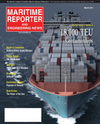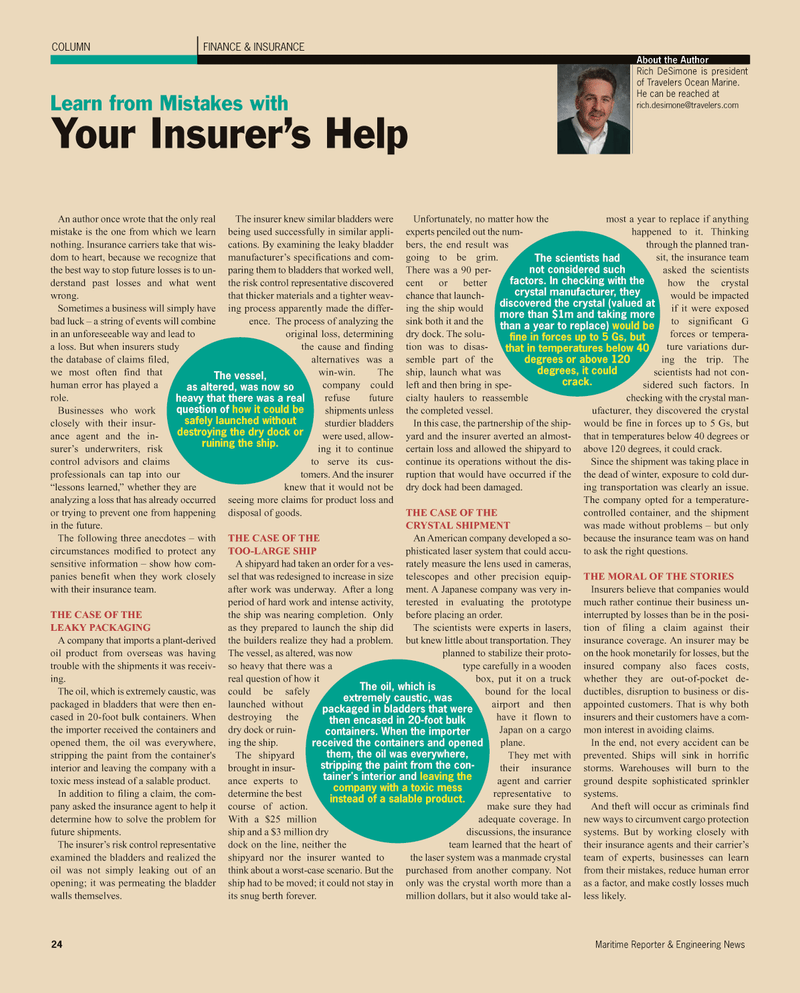
Page 24: of Maritime Reporter Magazine (March 2011)
Ship Repair & Conversion
Read this page in Pdf, Flash or Html5 edition of March 2011 Maritime Reporter Magazine
24 Maritime Reporter & Engineering News
An author once wrote that the only real mistake is the one from which we learn nothing. Insurance carriers take that wis- dom to heart, because we recognize that the best way to stop future losses is to un- derstand past losses and what went wrong.
Sometimes a business will simply have bad luck – a string of events will combine in an unforeseeable way and lead to a loss. But when insurers study the database of claims filed, we most often find that human error has played a role.
Businesses who work closely with their insur- ance agent and the in- surer’s underwriters, risk control advisors and claims professionals can tap into our “lessons learned,” whether they are analyzing a loss that has already occurred or trying to prevent one from happening in the future.
The following three anecdotes – with circumstances modified to protect any sensitive information – show how com- panies benefit when they work closely with their insurance team.
THE CASE OF THE
LEAKY PACKAGING
A company that imports a plant-derived oil product from overseas was having trouble with the shipments it was receiv- ing.
The oil, which is extremely caustic, was packaged in bladders that were then en- cased in 20-foot bulk containers. When the importer received the containers and opened them, the oil was everywhere, stripping the paint from the container's interior and leaving the company with a toxic mess instead of a salable product.
In addition to filing a claim, the com- pany asked the insurance agent to help it determine how to solve the problem for future shipments.
The insurer’s risk control representative examined the bladders and realized the oil was not simply leaking out of an opening; it was permeating the bladder walls themselves.
The insurer knew similar bladders were being used successfully in similar appli- cations. By examining the leaky bladder manufacturer’s specifications and com- paring them to bladders that worked well, the risk control representative discovered that thicker materials and a tighter weav- ing process apparently made the differ- ence. The process of analyzing the original loss, determining the cause and finding alternatives was a win-win. The company could refuse future shipments unless sturdier bladders were used, allow- ing it to continue to serve its cus- tomers. And the insurer knew that it would not be seeing more claims for product loss and disposal of goods.
THE CASE OF THE
TOO-LARGE SHIP
A shipyard had taken an order for a ves- sel that was redesigned to increase in size after work was underway. After a long period of hard work and intense activity, the ship was nearing completion. Only as they prepared to launch the ship did the builders realize they had a problem.
The vessel, as altered, was now so heavy that there was a real question of how it could be safely launched without destroying the dry dock or ruin- ing the ship.
The shipyard brought in insur- ance experts to determine the best course of action.
With a $25 million ship and a $3 million dry dock on the line, neither the shipyard nor the insurer wanted to think about a worst-case scenario. But the ship had to be moved; it could not stay in its snug berth forever.
Unfortunately, no matter how the experts penciled out the num- bers, the end result was going to be grim.
There was a 90 per- cent or better chance that launch- ing the ship would sink both it and the dry dock. The solu- tion was to disas- semble part of the ship, launch what was left and then bring in spe- cialty haulers to reassemble the completed vessel.
In this case, the partnership of the ship- yard and the insurer averted an almost- certain loss and allowed the shipyard to continue its operations without the dis- ruption that would have occurred if the dry dock had been damaged.
THE CASE OF THE
CRYSTAL SHIPMENT
An American company developed a so- phisticated laser system that could accu- rately measure the lens used in cameras, telescopes and other precision equip- ment. A Japanese company was very in- terested in evaluating the prototype before placing an order.
The scientists were experts in lasers, but knew little about transportation. They planned to stabilize their proto- type carefully in a wooden box, put it on a truck bound for the local airport and then have it flown to
Japan on a cargo plane.
They met with their insurance agent and carrier representative to make sure they had adequate coverage. In discussions, the insurance team learned that the heart of the laser system was a manmade crystal purchased from another company. Not only was the crystal worth more than a million dollars, but it also would take al- most a year to replace if anything happened to it. Thinking through the planned tran- sit, the insurance team asked the scientists how the crystal would be impacted if it were exposed to significant G forces or tempera- ture variations dur- ing the trip. The scientists had not con- sidered such factors. In checking with the crystal man- ufacturer, they discovered the crystal would be fine in forces up to 5 Gs, but that in temperatures below 40 degrees or above 120 degrees, it could crack.
Since the shipment was taking place in the dead of winter, exposure to cold dur- ing transportation was clearly an issue.
The company opted for a temperature- controlled container, and the shipment was made without problems – but only because the insurance team was on hand to ask the right questions.
THE MORAL OF THE STORIES
Insurers believe that companies would much rather continue their business un- interrupted by losses than be in the posi- tion of filing a claim against their insurance coverage. An insurer may be on the hook monetarily for losses, but the insured company also faces costs, whether they are out-of-pocket de- ductibles, disruption to business or dis- appointed customers. That is why both insurers and their customers have a com- mon interest in avoiding claims.
In the end, not every accident can be prevented. Ships will sink in horrific storms. Warehouses will burn to the ground despite sophisticated sprinkler systems.
And theft will occur as criminals find new ways to circumvent cargo protection systems. But by working closely with their insurance agents and their carrier’s team of experts, businesses can learn from their mistakes, reduce human error as a factor, and make costly losses much less likely.
COLUMN
Learn from Mistakes with
Your Insurer’s Help
FINANCE & INSURANCE
About the Author
Rich DeSimone is president of Travelers Ocean Marine.
He can be reached at [email protected]
The vessel, as altered, was now so heavy that there was a real question of how it could be safely launched without destroying the dry dock or ruining the ship.
The oil, which is extremely caustic, was packaged in bladders that were then encased in 20-foot bulk containers. When the importer received the containers and opened them, the oil was everywhere, stripping the paint from the con- tainer's interior and leaving the company with a toxic mess instead of a salable product.
The scientists had not considered such factors. In checking with the crystal manufacturer, they discovered the crystal (valued at more than $1m and taking more than a year to replace) would be fine in forces up to 5 Gs, but that in temperatures below 40 degrees or above 120 degrees, it could crack.

 23
23

 25
25
